Carl Gustav Jung y la Psicología Analítica
martes, 19 de noviembre de 2013
jueves, 11 de julio de 2013
What is Depth Psychology?
Depth Psychology refers to approaches to therapy that are open to the exploration of the subtle, unconscious, and transpersonal aspects of human experience. A depth approach may include therapeutic traditions that explores the unconscious and involves the study and exploration of dreams, complexes, and archetypes. Depth psychology is non-pathologizing and strength affirming.
The approach is based on the theories of Carl Gustav Jung (1875-1961), a Swiss psychiatrist who developed Analytical Psychology. This approach focuses on the psyche, human development, personality formation, and individuation. Individuation is a process of bringing our unconscious potential into a concrete living reality. This process helps to secure a bridge between an individual and the unconscious as well as the individual and his/her wider community. By incorporating both an inner and outer exploration, one discovers a more potent sense of meaning and purpose in life.
Carl Jung believed that psychological distress is a result of an imbalance within the individual that often is experienced as an alienation from the deeper personality, or what he calls the Self. Jungian psychotherapy seeks to restore the individual’s connection to the Self. This effort can be achieved through the therapeutic relationship, dream interpretation, active imagination, and work with expressive therapies.
sábado, 9 de marzo de 2013
domingo, 27 de enero de 2013
Ouroboros

Symbolic representation of coming full circle (cycle)
The Ouroboros is an ancient symbol depicting a serpent or dragon eating its own tail. The name originates from within Greek language; (oura) meaning "tail" and (boros) meaning "eating", thus "he who eats the tail".
The Ouroboros represents the perpetual cyclic renewal of life and infinity, the concept of eternity and the eternal return, and represents the cycle of life, death and rebirth, leading to immortality, as in the Phoenix.
The current mathematical symbol for infinity - may be derived from a variant on the classic Ouroboros with the snake looped once before eating its own tail, and such depictions of the double loop as a snake eating its own tail are common today in fantasy art and fantasy literature, though other conjectures also exist.
It can also represent the idea of primordial unity related to something existing in or persisting before any beginning with such force or qualities it cannot be extinguished. The ouroboros has been important in religious and mythological symbolism, but has also been frequently used in alchemical illustrations, where it symbolizes the circular nature of the alchemist's opus. It is also often associated with Gnosticism and Hermeticism.
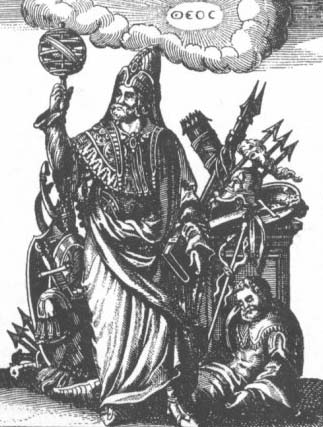
Showing itself primarily in ancient Gnostic texts, the Ouroboros is any image of a snake, worm, serpent, or dragon biting its own tail. Generally taking on a circular form, the symbol is representative of many broad concepts. Time, life continuity, completion, the repetition of history, the self-sufficiency of nature, and the rebirth of the Earth can all be seen within the circular boundaries of the Ouroboros.
Societies from throughout history have shaped the Ouroboros to fit their own beliefs and purposes. The image has been seen in ancient Egypt, Japan, India, utilized in Greek alchemic texts, European woodcuts, Native American Indian tribes, and by the Aztecs. It has, at times, been directly associated to such varying symbols as the Roman god Janus, the Chinese Ying Yang, and the Biblical serpent in the Garden of Eden.

Symbolic representation of coming full circle (cycle)
The Ouroboros is an ancient symbol depicting a serpent or dragon eating its own tail. The name originates from within Greek language; (oura) meaning "tail" and (boros) meaning "eating", thus "he who eats the tail".
The Ouroboros represents the perpetual cyclic renewal of life and infinity, the concept of eternity and the eternal return, and represents the cycle of life, death and rebirth, leading to immortality, as in the Phoenix.
The current mathematical symbol for infinity - may be derived from a variant on the classic Ouroboros with the snake looped once before eating its own tail, and such depictions of the double loop as a snake eating its own tail are common today in fantasy art and fantasy literature, though other conjectures also exist.
It can also represent the idea of primordial unity related to something existing in or persisting before any beginning with such force or qualities it cannot be extinguished. The ouroboros has been important in religious and mythological symbolism, but has also been frequently used in alchemical illustrations, where it symbolizes the circular nature of the alchemist's opus. It is also often associated with Gnosticism and Hermeticism.

Societies from throughout history have shaped the Ouroboros to fit their own beliefs and purposes. The image has been seen in ancient Egypt, Japan, India, utilized in Greek alchemic texts, European woodcuts, Native American Indian tribes, and by the Aztecs. It has, at times, been directly associated to such varying symbols as the Roman god Janus, the Chinese Ying Yang, and the Biblical serpent in the Garden of Eden.
2012
The Ouroboros is believed to have been inspired by the Milky Way.

Ancient texts refer to a serpent of light residing in the heavens
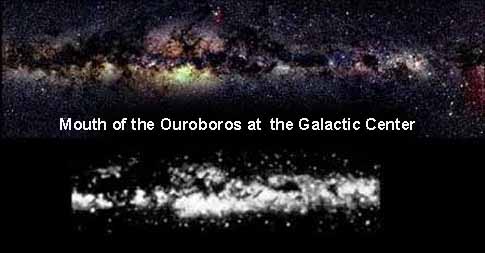
which, according to Ancient Alien Theory, was a spaceship or stargate.
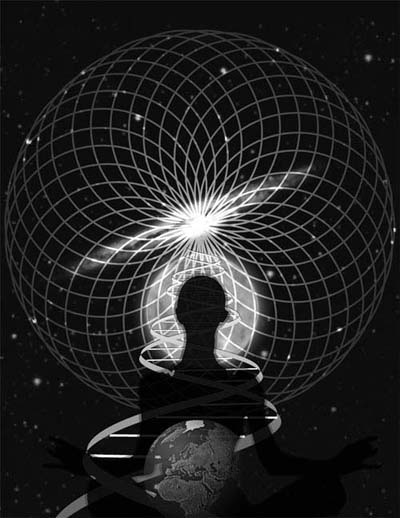
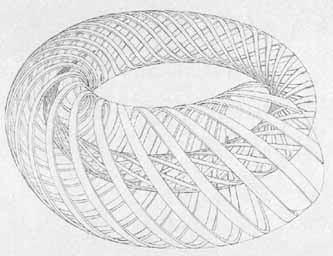
Tube Torus
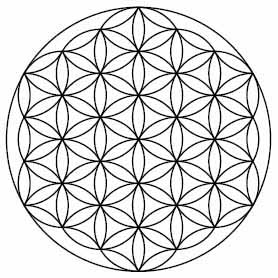
Flower of Life
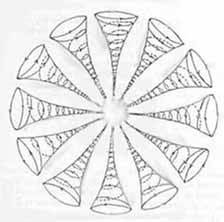
12 Around 1 - Alchemy Wheel
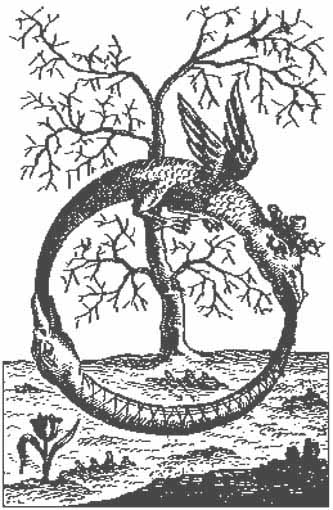
The Ouroboros and the Tree of Life
Origins of the Ouroboros
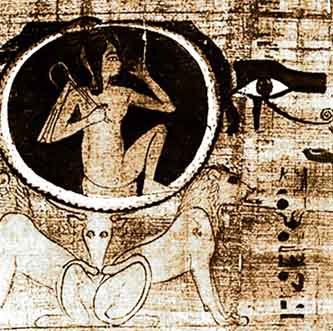
Papyrus of Dama Heroub Egypt, 21st Dynasty
In the Book of the Dead, which was still current in the Graeco-Roman period, the self-begetting sun god Atum is said to have ascended from chaos-waters with the appearance of a snake, the animal renewing itself every morning, and the deceased wishes to turn into the shape of the snake Sato ("son of the earth"), the embodiment of Atum.
The famous Ouroboros drawing from the early alchemical text The Chrysopoeia of Cleopatra dating to 2nd century Alexandria encloses the words hen to pan, "one is the all". Its black and white halves represent the Gnostic duality of existence. As such, the Ouroboros could be interpreted as the Western equivalent of the Taoist Yin-Yang symbol. The Chrysopoeia Ouroboros of Cleopatra is one of the oldest images of the Ouroboros to be linked with the legendary opus of the Alchemists, the Philosopher's Stone.
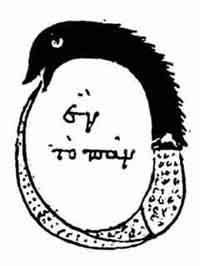
Of design he was created thus, his own waste providing his own food, and all that he did or suffered taking place in and by himself. For the Creator conceived that a being which was self-sufficient would be far more excellent than one which lacked anything; and, as he had no need to take anything or defend himself against any one, the Creator did not think it necessary to bestow upon him hands: nor had he any need of feet, nor of the whole apparatus of walking; but the movement suited to his spherical form was assigned to him, being of all the seven that which is most appropriate to mind and intelligence; and he was made to move in the same manner and on the same spot, within his own limits revolving in a circle.
All the other six motions were taken away from him, and he was made not to partake of their deviations. And as this circular movement required no feet, the universe was created without legs and without feet. In Gnosticism, this serpent symbolized eternity and the soul of the world.
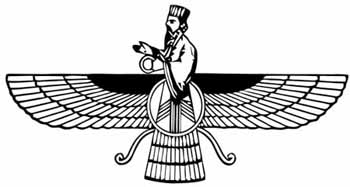
In Mithran mystery cults the figure of Mithra being reborn (one of the things he is famous for) is sometimes seen wrapped with an ouroboros, indicating his eternal and cyclic nature, and even references which do not mention the ouroboros refer to this circular shape as symbolizing the immortality of the soul or the cyclic nature of Karma, suggesting that the circle retains its meaning even when the details of the image are obscured.
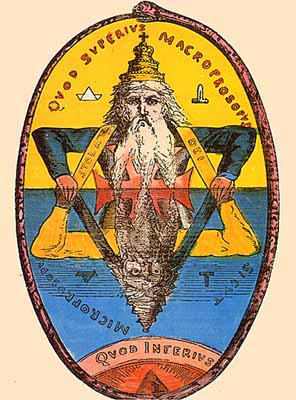
The Double Triangle of Solomon
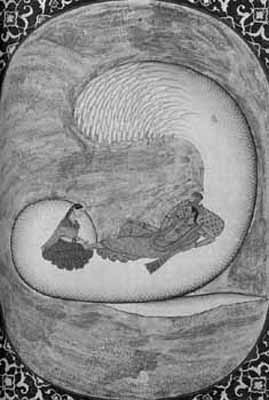
The Kirtimukha myth of Hindu tradition has been compared by some authors to Ouroboros.
Ouroboros... the dragon circling the tortoise which supports the four elephants that carry the world.
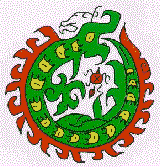
Chinese Ouroboros from Chou dynasty, 1200 BC.
Correspondingly, the Chinese believed Light and Darkness, as the ideal opposites, when united, yielded creative energy. The two opposites were further conceived as matter and energy which became dual-natured but as one. The two opposites were yin-yang and their unity was called Chhi. Yin-Yang was treated separately in Chinese cosmology which consisted of five cosmic elements.
Since Chinese alchemy did reach Alexandria probably the symbol Yin-Yang, as dual-natured, responsible for creation, was transformed into a symbol called Ouroboros. It is a snake and as such as symbol of soul. Its head and anterior portion is red, being the color of blood as soul; its tail and posterior half is dark, representing body.
Ouroboros here is depicted white and black, as soul and body, the two as "one which is all." It is cosmic soul, the source of all creation. Ouroboros is normally depicted with its anterior half as black but it should be the reverse as shown here. With the name Chemeia taken to Kim-Iya, the last word would take Ouroboros to Yin-Yang.
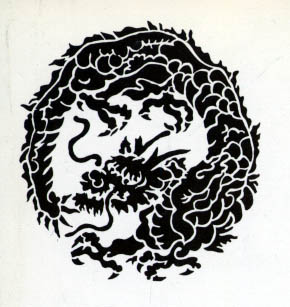
Pre 1400 Japan
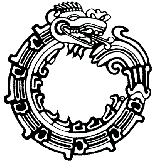 Seven-segmented Aztec Ouroboros
Seven-segmented Aztec Ouroboros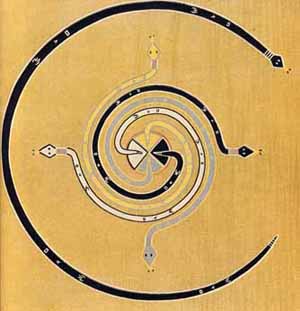
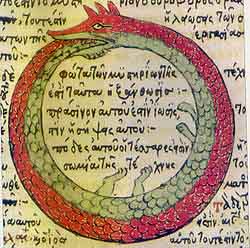
It could very well be used to symbolize the closed-system model of the universe of some physicists even today.'
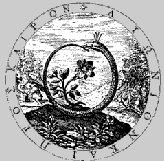
Earthly Ouroboros from Alciato's Emblems

Oceanic Ouroboros from Alciato's Emblems
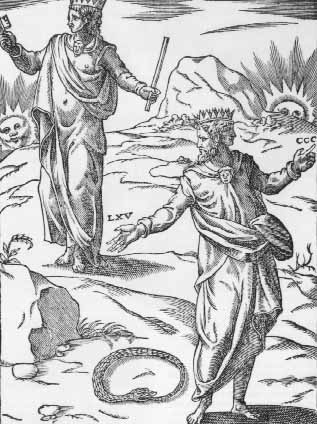
Janus 1608

The ouroboros is displayed on numerous Masonic seals,
frontispieces and other imagery, especially during the 17th century.
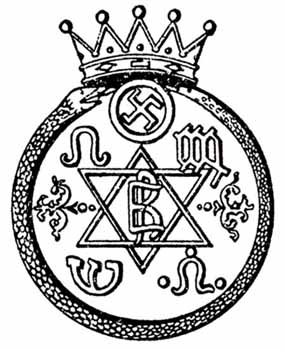
The Ouroboros is featured in the seal of the Theosophical Society
along with other traditional symbols.
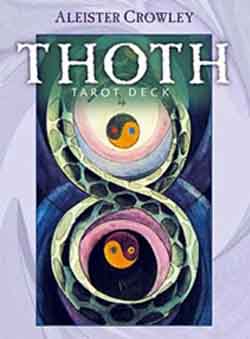
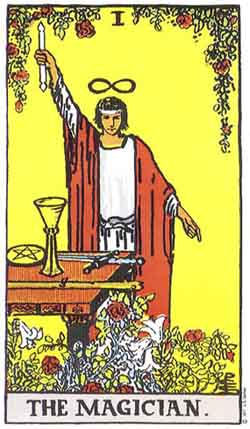
A commonly used early symbol - an ace of cups circled by an ouroboros - frequently appears among Albigensian watermarks. It is conceivable that this is the source of some of the urban legends associating this symbol with secret societies, because the Albigenses were closely associated with the humanist movement and the inquisition it sparked.
The word Ouroboros is really a term that describes a similar symbol which has been cross-pollinated from many different cultures. Its symbolic connotation from this owes to the returning cyclical nature of the seasons; the oscillations of the night sky; self-fecundation; disintegration and re-integration; truth and cognition complete; the Androgyny; the primeval waters; the potential before the spark of creation; the undifferentiated; the Totality; primordial unity; self-sufficiency, and the idea of the beginning and the end as being a continuous unending principle.
Ouroboros represents the conflict of life as well in that life comes out of life and death. 'My end is my beginning.' In a sense life feeds off itself, thus there are good and bad connotations which can be drawn. It is a single image with the entire actions of a life cycle - it begets, weds, impregnates, and slays itself, but in a cyclical sense, rather than linear.
Thus, it fashions our lives to a totality more towards what it may really be - a series of movements which repeat. "As Above, So Below" - we are born from nature, and we mirror it, because it is what man wholly is a part of. It is this symbolic rendition of the eternal principles that are presented in the Emerald Tablets of Thoth.
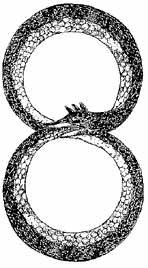 The Ouroboros connects the Above and Below
The Ouroboros connects the Above and Below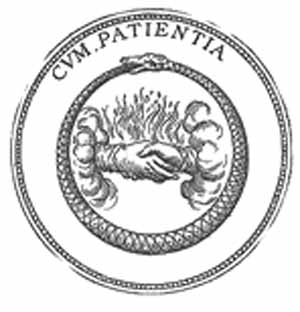
Connection between Man and God
- The alchemists, who in their own way knew more about the nature of the individuation process than we moderns do, expressed this paradox through the symbol of the ouroboros, the snake that eats its own tail. In the age-old image of the ouroboros lies the thought of devouring oneself and turning oneself into a circulatory process, for it was clear to the more astute alchemists that the prima materia of the art was man himself.The ouroboros is a dramatic symbol for the integration and assimilation of the opposite, i.e. of the shadow. This 'feed-back' process is at the same time a symbol of immortality, since it is said of the ouroboros that he slays himself and brings himself to life, fertilizes himself and gives birth to himself. He symbolizes the One, who proceeds from the clash of opposites, and he therefore constitutes the secret of the prima materia which [...] unquestionably stems from man's unconscious'. (Collected Works, Vol. 14 para.513)
The 19th century German chemist named Kekule dreamed of a snake with its tail in its mouth one day after dosing off. He had been researching the molecular structure of benzene, and was at a stop point in his work until after waking up he interpreted the dream to mean that the structure was a closed carbon ring. This was the breakthrough he needed.
Organic chemist August Kekule claimed that a ring in the shape of Ouroboros that he saw in a dream inspired him in his discovery of the structure of the benzene ring.
Today the Ouroboros is often found as a tattoo.
The X-Files' Dana Scully chose the Ouroboros to be tattooed on her back because she felt it represented the progression of her life. It seems that the Ouroboros is a powerful archetypal symbol, a part of our Spiritus Mundi, the collective unconscious which thrives within each soul.
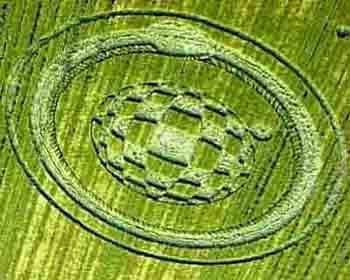
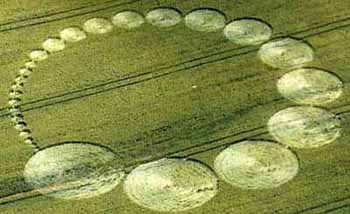
ALCHEMY INDEX
MATHEMATICS INDEX
PHYSICAL SCIENCES INDEX
ALPHABETICAL INDEX OF ALL FILES
CRYSTALINKS HOME PAGE
PSYCHIC READING WITH ELLIE
2012 THE ALCHEMY OF TIME

Ouroboros, archetype and the basic mandala
Jung saw the ouroboros as an archetype and the basic mandala of alchemy He defined the relationship of
the ouroboros to alchemy as:
The alchemists, who in their own way know more about the nature of the individuation process
than we moderns do, expressed this paradox through the symbol of the ouroboros, the snake that
eats its own tail. In the age old image of the ouroboros lies the thought of devouring oneself and
turning oneself into a circulatory process, for it was clear to the most astute alchemists that the
prima materia of the art was man himself.
The ouroboros is a dramatic symbol for the integration and assimilation of the opposite, i.e. of the
shadow self. This feed back process is at the same time a symbol of immortality, since it is said of
the ouroboros that he slays himself and brings himself t life again, fertilizes himself and gives birth
to himself. This is much like the cycle of the Phoenix, the feminine archetype.
Ouroboros symbolizes The One, who proceeds from the clash of opposites, and therefore
constitutes the secret of the prima materia which unquestionably stems from man's
unconsciousness.
(Collective Works Vol. 14)
miércoles, 5 de diciembre de 2012
The art of psychology
Carl Jung has spirit guides, one of who was named Philemon. Could that name be linked to the Phi Ratio
of Sacred Geometry
Jung observed that Philemon and other figures of his fantasies gave him crucial insights. To this end he
referred to things in the psyche, which he could produce, but which could produce themselves, as having
their own life. Philemon represented a force that was other than himself, much like a channeler or
medium in today's world gets information from allegedly a source from the other side. he greatly enjoyed
these conversations as a learning tool.
Psychologically, Philemon represents superior insight to Jung. To those who do not study metaphysics,
Philemon might be perceived as a figment of Jung's imagination, or a reflection of a mental illness. Jung
did not consider himself insane. He believed that Philemon was a source of legitimate information,
whose validity could be tested in fact. This opened the door to his theory of a collective
unconsciousness, a type of library, if you will, containing everything ever known and recorded, replete
with archetypes and active principles that interacted between that source and human consciousness.
Jung had a life long fascination with Friedrich Nietzsche (1844-1900), but he distanced himself from
Nietzsche for fear he would would suffer the same fate, mental illness in his old age.
Jung's book Thus Spoke Zarathustra (Also Sprach Zarathustra) chronicles the wanderings and teachings
of Zarathustra, Zoroaster, the ancient Persian prophet who founded Zoroastrianism.
Zarathustra
Also Sprach Zarathustra is also the title of a symphonic poem by Richard Strauss, composed in 1896 and
inspired by the book. It is best known for its use in Stanley Kubrick's 1968 film 2001: A Space Odyssey,
which is postulated to have been inspired by the book, at least in part. The opening section is used three
times, most famously in the opening title sequence of the film.
Philemon was not the only entity Jung channeled. Among the others was a cultivated elderly Indian who
told Jung that his experience was identical to many mystics. In this case his spirit guide, teacher or guru,
said that he had been a commentator on the Vedas, centuries before. Jung felt that he had become as one
with the ancient teachers and priests, and others thought to have experienced the divine.
In 1916 Jung made a connection with Basilides. Basilides (early 2nd century), was an early Christian
religious teacher in Alexandria, Egypt. Basilides apparently wrote twenty-four books on the Gospel and
promoted a dualism influenced by Zoroastrianism. His followers formed a Gnostic sect, the Basilideans.
Historians know of Basilides and his teachings only through the writings of his detractors, Agrippa
Castor, Irenæus, Clement of Alexandria, and Hippolytus. It is impossible to determine how reliable these
hostile accounts are. Jung transcribed Septem Sermones ad Mortuos as dictated to him by Basilides of
Alexandria.
Channeling Basilides was in some ways considered a possession to Jung. He felt that his house may be
haunted, especially when his eldest daughter saw a white ethereal figure passing through the room. His
second daughter, independent of the eldest daughter's observation, related that twice the same night her
blanket has been thrown to the floor. Jung's nine year old son, experienced an anxiety dream that night
waking up terrified.
Around five o'clock that afternoon, the front doorbell continued to ring without stopping. It was a bright
summer day. the two maids were in the kitchen, from which the open they could view the door.
Everyone looked to see who was ringing the bell, but there was no one in sight as the bell could be seen
moving in and out. An explanation was never found.
Jung became frightened. He shouted out, "For God's sake, what madness is this?" Voices cried out in
chorus, "We have come back from Jerusalem where we found not what we sought."
Over the next three evenings, Jung quickly finished the book. As soon as he began to write, the ghostly
assemblage, the hauntings, stopped.
Jung's channelings of Basilides has been labeled a core text of depth psychology. The text is intriguing
for several reasons. For one, he uses the name Abraxas to describe the Supreme Being that had originally
generated mind, nous, consciousness and then other powers of consciousness into thought.
Jung did not teach the return of human essence to the Gnostic pleroma wherein individuality was lost.
Instead he adhered to individualism, which maintained the fullness of human individuality.
In metaphysics we often read that both possibilities can be encountered, and found in some religions.
The soul at its final stage can become one with source (pleroma) or maintain its separate identity inside
the One (individuation).
The easiest parallel is with the hologram, in which each 'replica' is unique, yet also the whole. If any
replica was aware, and would at one point have to ask what it wanted, some would ask to surrender into
the greater hologram, whereas other replicas would ask to retain their individual memories, though part
of the whole.
It is clear that this experience created the framework in which the concept of the collective
unconsciousness would later evolve, information transfered from a collective mind to groups or
individuals.
On the matter of his automatic writing, he later wrote, "These conversations with the dead formed a kind
of prelude to what I had to communicate to the world about the unconsciousness. All my works, all my
creative activity, have come from those initial 'connections', fantasies and dreams which began in 1912,
almost 50 years ago. Everything that I accomplished in later life was already contained in them, although
at first only in the form of emotions and images."
As early as August 1912, Jung had intimated a letter to Freud that he had an intuition that the essentially
feminine-tones archaic wisdom of the Gnostics, symbolically called Sophia, was destined to re-enter
modern Western culture by way of depth psychology. This takes us to the Gnostic text the Pistis Sophia.
Pistis Sophia is an important Gnostic text. The five remaining copies, which scholars date c. 250300
AD, relate the Gnostic teachings of the transfigured Jesus to the assembled disciples (including
his mother Mary, Mary Magdalene, and Martha), when the risen Christ had accomplished eleven
years speaking with his disciples. In it the complex structures and hierarchies of heaven familiar in
Gnostic teachings are revealed.
The female divinity of gnosticism is Sophia, a being with many aspects and names. She is
sometimes identified with the Holy Ghost itself but, according to her various capacities, is also the
Universal Mother, the Mother of the Living or Resplendent Mother, the Power on High, She-ofthe-
left-hand (as opposed to Christ, understood as her husband and he of the Right Hand), as the
Luxurious One, the Womb, the Virgin, the Wife of the Male, the Revealer of Perfect Mysteries, the
Saint Columba of the Spirit, the Heavenly Mother, the Wandering One, or Elena (that is, Selene,
the Moon). She was envisaged as the Psyche of the world and the female aspect of Logos.
The title Pistis Sophia is obscure, and is sometimes translated Faith wisdom or Wisdom in faith or
Faith in wisdom. A more accurate translation taking into account its gnostic context, is the faith of
Sophia, as Sophia to the gnostics was a divine syzygy of Christ, rather than simply a word
meaning wisdom. In an earlier, simpler version of a Sophia, in the Berlin Codex and also found in
a papyrus at Nag Hammadi, the transfigured Christ explains Pistis in a rather obscure manner:
Again, his disciples said: Tell us clearly how they came down from the invisibilities, from the
immortal to the world that dies? The perfect Saviour said, "Son of Man consented with Sophia, his
consort, and revealed a great androgynous light. Its male name is designated 'Saviour, begetter of
all things'. Its female name is designated 'All-begettress Sophia'. Some call her 'Pistis'."
The best-known of the five manuscripts of Pistis Sophia is bound with another Gnostic text titled
on the binding "Piste Sophiea Cotice". This "Askew Codex" was purchased by the British Museum
in 1795 from a Dr. Anthony Askew. Until the discovery of the Nag Hammadi library in 1945, the
Askew Codex was one of three codices that contained almost all of the gnostic writings that had
survived the suppression of such literature both in East and West, the other two codices being the
Bruce Codex and the Berlin Codex. Aside from these sources, everything written about Gnosticism
before World War II is based on quotes, references and inferences in the Patristic writings of the
enemies of Gnosticism, a less-than-neutral source, where Gnostic beliefs were selected to present
their absurdities, bizarre and unethical behavior, and heresy from the orthodox Pauline Christian
standpoint.
The text proclaims that Jesus remained on earth after the resurrection for 11 years, and was able in
this time to teach his disciples up to the first (i.e. beginner) level of the mystery. It starts with an
allegory paralleling the death and resurrection of Jesus, and describing the descent and ascent of
the soul. After that it proceeds to describe important figures within the gnostic cosmology, and
then finally lists 32 carnal desires to overcome before salvation is possible, overcoming all 32
constituting salvation.
Pistis Sophia includes quotes from five of the Odes of Solomon, found in chapters between 58 and
71. Pistis Sophia was the only known source for the actual wording of any of the Odes until the
discovery of a nearly-complete Syriac text of the Odes in 1909. Because the first part of this text is
missing, Pistis Sophia is still the only source for Ode 1.
It is clear that Jung was seeing and defining what we call the Return of (to) the Feminine Energies or
higher frequency of thought consciousness. Jung also channeled feminine archetypes including Salome.
In 1926 Jung had a remarkable dream. He was back in the 17th century where he saw himself as an
alchemist doing important work. Jung believe that alchemy was the connection between the ancient
world of the gnostics and the modern era, which would seethe return of Sophia (mother goddess
energies).
For Jung, alchemy was not the search for a way to transform lead into gold, but the transformation of the
soul on its path to perfection. Jung's dreams in 1926 and on frequently found him in ancient places
surrounded by alchemical codices of great beauty and mystery. Jung amassed a library on the great art
which represents one of the finest private collections in this field.
In 1944 Jung published Psychology and Alchemy in which he argues for a reevaluation of the
symbolism of Alchemy as being intimately related to the psychoanalytical process. Using a cycle of
dreams of one of his patients he shows how the symbols used by the Alchemists occur in the psyche as
part of the reservoir of mythological images drawn upon by the individual in their dream states. Jung
draws an analogy between the Great Work of the Alchemists and the process of reintegration and
individuation of the psyche in the modern psychiatric patient.
Jung believed that the cosmos contained the divine light or life, but this essence was enmeshed in a
mathematical trap, presided over by a demiurge, Lucifer, the Bringer of Light. Lucifer contained the
light inside this reality, until a time when it would be set free. The first operation of alchemy therefore
addressed itself to the dismemberment of this confining structure, reducing it to the condition of creative
chaos. From this, in the process of transformation, the true, creative binaries emerge and begin their
interaction designed to bring the alchemical union. In this ultimate union, says Jung, the previously
confined light is redeemed and brought to the point of its ultimate and redemptive fulfillment.
Jung made it clear that his theory was not new. It is similar to the Catharism and he stated that he was
restating the Hermetic Gnosis and explaining the misunderstood central quest of alchemy.
Jung believed that alchemy stood in a compensatory relationship to mainstream Christianity, rather like a
dream does to the conscious attitudes of the dreamer. It has been has been hidden underground, part of a
secret tradition that ran throughout Christianity, but always subconsciousness - visible by its shadows
and the traces it leaves.
He also felt that this process allowed for better understanding of male-female relationships, and the
concept of love. In the Psychology of Transference Jung stated that in love, as in psychological growth,
the key to success is the ability to endure the tension of opposites without abandoning the process, even
if its results appear to have been brought to naught. In essence, it is the stress that allows one to grow
and transform.
The union of opposites, the focus of the alchemist, was for Jung also the focus of Gnostics, whom he felt
had been incorrectly labeled as radical dualists, i.e. believing in the battle between good and evil without
any apparent union possible between the two.
For Jung, dualism and monism were not mutually contradictory and exclusive, but complimentary
aspects of reality. As such, there was no right and wrong, no order or chaos, just two opposites, duality,
polarities, that created a means to reconciliation and balance into enlightenment.
In a maner of speaking one could call Carl Jung the Father if the New Age of Consciousness, giving a
theoretical framework for channeling and other New Age practices that allow consciousness to expand
outside the box of antiquated thinking.
In the end, Carl Jung stated that such opposites must be integrated. Zoroaster calls this Zero Point.
Jung believed in an Illuminated Psyche, which goes to the Illuminati, enlightenment through the Eye
Symbology, All Seeing Eye and other major archetypes of the Masonic Program through which we
experience and learn.
Suscribirse a:
Entradas (Atom)